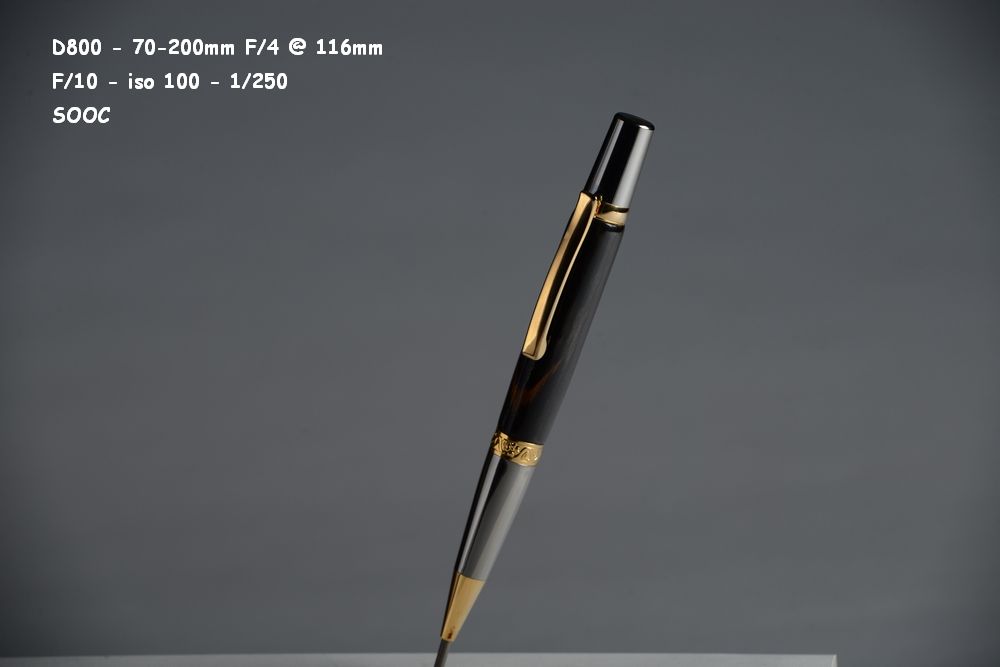Polarizing film and circular polarizing filter vs shiny stuff
I'd like to share my relatively inexpensive foray into cross polarization.
I purchased 4' long x 17" wide piece of film from here.
Including shipping to Canada the cost was $90, that's enough material (17" x 16") for three 20" x 20" softboxes. The intended use is smallish product.
I also purchased an off shore lens collar for the 70-200mm (ebay $20), Hoya Pro 1 CP filters (ebay $140) and rubber lens hoods (ebay $10) for the 24-70mm and 70-200mm.

To attach the film to the softboxes I basically cut a hole in white foam core a 1/2" smaller than the film and taped it to the opening, then hot glued a 2" wide border around the panel.

A simple paper clip holds the frame on the softbox.


First test shot with a handmade ebony pen in landscape orientation to check for vignetting.

Very minor editing...

Next was a test shot in portrait mode with a pen that was handmade for me as a gift. The pen blank is made up of shredded $50 bills in resin.
Credit to Mack Cameron, the pen maker..

BTW - the reflections on the collars on this pen drove me crazy until I viewed it closely in natural light and noticed they are indeed faceted.
I'm not sure of the math when the lights are reflected onto the subject or used from above but I do know this bit of "kit" will be very useful in my work.
Cheers, Don
I purchased 4' long x 17" wide piece of film from here.
Including shipping to Canada the cost was $90, that's enough material (17" x 16") for three 20" x 20" softboxes. The intended use is smallish product.
I also purchased an off shore lens collar for the 70-200mm (ebay $20), Hoya Pro 1 CP filters (ebay $140) and rubber lens hoods (ebay $10) for the 24-70mm and 70-200mm.

To attach the film to the softboxes I basically cut a hole in white foam core a 1/2" smaller than the film and taped it to the opening, then hot glued a 2" wide border around the panel.

A simple paper clip holds the frame on the softbox.


First test shot with a handmade ebony pen in landscape orientation to check for vignetting.

Very minor editing...

Next was a test shot in portrait mode with a pen that was handmade for me as a gift. The pen blank is made up of shredded $50 bills in resin.
Credit to Mack Cameron, the pen maker..

BTW - the reflections on the collars on this pen drove me crazy until I viewed it closely in natural light and noticed they are indeed faceted.
I'm not sure of the math when the lights are reflected onto the subject or used from above but I do know this bit of "kit" will be very useful in my work.
Cheers, Don
0
Comments
I can see how this setup can be quite useful for controlling reflections.
Thanks for posting this, Don!
Moderator of the Technique Forum and Finishing School on Dgrin
Here's some shots for comparison..
Bare naked lens/softbox's.
Circular Polarizer.
Circular Polarizer and more power.
Bare lens and polarizing film on softboxes.
And a step back shot.
Cheers, Don
Product Photography
My Acreage Bird Photographs
GaryB
“The single most important component of a camera is the twelve inches behind it!” - Ansel Adams
I'll be looking for your posts
Cheers, Don
Product Photography
My Acreage Bird Photographs
(tin can tied to the bumper)
This is the film I purchased.
You may want to try a circular polarizer on your lens first before moving on to cross polarization...
Cheers, Don
Product Photography
My Acreage Bird Photographs
By that I mean use white foamcore and reflect the light off the foamcore onto the object. And/or try black, whatever color you use will be reflected by the metal.
Cheers, Don
Product Photography
My Acreage Bird Photographs
...yessir, Don...been fishin' around and have arrived at a good beginning strategy. In effect I'm shooting a mirror, that's the dicey part. Yesterday I managed to get decent results except for 45 degrees or so coming back to the camera, so I've got a plan, with some of your input, to deal with that...we'll see and I'll keep you in the loop. Oh, I also contract wood jobs (and a kitchen or two) and am finding my way into canvas and framing...fun! And it's nice to have *our* skillset!
(tin can tied to the bumper)